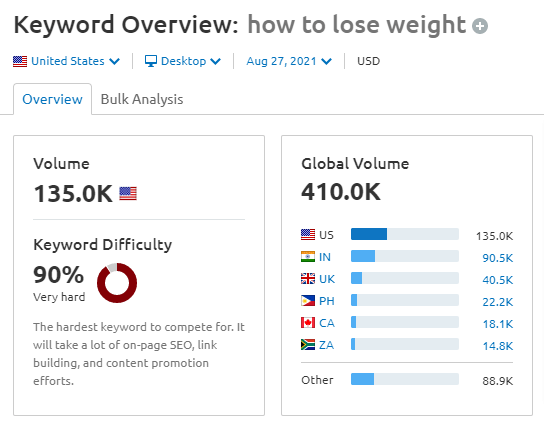Let’s face it: 80% of the content on the internet sucks.
How often do we research a topic and find articles full of useless and generic advice that we already know?
Too often.
The truth is, this is partly because sometimes we have the answers – but are looking for some magic push-button solution to our problems. We all do it.
But the generic content that tells us things we already know isn’t exactly helpful.
As a content writer, you can use really specific examples (or success stories) to take generic advice and turn it into actionable information.
In this article, I’m going to show you how you can do EXACTLY that.
Why Using Specific Examples Will Make Your Content So Much Better

The search term “how to lose weight” gets a whopping 410,000+ searches per month – according to SEMrush.
But the truth is – I think the large majority of those searchers knows:
- You have to do cardio
- You should get lots of sleep.
- You should drink lots of water
- You have to eat fewer calories than you burn
But if you tell them that, it’s pretty dull, and visitors won’t want to stay on your site (sad face).
Now have fun trying to get them to buy your products and services.
What To Do Instead
Instead, imagine – you show them:
- Your favorite low-calorie, delicious, and filling meals (with links to the meals)
- Your favorite cardio exercises that turned us from lazy pizza heads to active and energetic individuals
- How you started loving drinking water, even though you used to live on coffee
- How you make your body naturally produce melatonin in the evenings (i.e., the hormone that makes you sleepy)
Not only does this make your article WAY more engaging – but it also makes it more actionable.
Telling someone to do something they already know they’re meant to be doing is not really actionable.
Teaching someone the exact method you used to get results is actionable.
Proof This Works
Think about: When have you have looked at a piece of content and taken action from it?
I guarantee the article was pretty detailed and included either examples or a personal story.
Nobody would read “Do exercise” and think: “hell yeah, I’m going to exercise now.”
A lot more people will take action on your example exercise that burns 100 calories in 5 minutes.
Every time you’ve tried a new self-improvement routine, marketing technique, or whatever you do – it’s because the content showed detailed examples – not generic advice.
And for the SEOs: This also makes internal linking easier because you are more likely to have more relevant pages on the example. Like in the earlier example, you could link to all your healthy, low-calorie meals if you have a weight loss site.
How To Create (or Find) Engaging Examples
When it comes to these examples, you’ll either have some personal success stories or you won’t.
Below, I’ve walked you through how you can create killer examples either way.
Focus on Results-driven Examples
This one is somewhat obvious – but I just wanted to ensure you understand why examples are effective.
The examples you should be using in your content should show your audience the result they want to achieve:
For example, the audience wants to lose weight? Show them examples of it.
The audience wants to generate more sales? Show them examples of it.
The audience wants to get more dates? Show them examples of it.
I think you get the point here.
Use examples that show results and PROVE why you are right.
Then, if the reader still doesn’t take action, it probably isn’t your fault.
Real-Life Experience (Or Not)
“Okay, but what if I don’t have any examples.”
Firstly, if you are writing for yourself or a business you work for – you or the company should have some examples.
But even if you don’t have any for whatever reason – you still can’t escape:
Go out there and find some. We have access to Google.

When you’re writing about how your audience should follow a specific workout plan… Find someone who has used similar training and write about it in your article – just add your value to it.
For example – let’s say you’re a freelance writer and write about growing a social media following for a marketing agency.
Don’t: Fill the article with generic advice and just say stay consistent, blah, blah.
Do: Find social media influencers or businesses that have seen some crazy growth – analyze how they did it and show it to your audience.
But still, ADD VALUE.
And finally – if it’s a topic where an explanation example makes sense, then use that as well.
Throughout this article, I’ve been showing you ways to build examples into your content – and I’ve pretty much only used examples that are an explanation.
These are explanation examples, work well in most cases, and are much easier to create.
Or in this case, I used to them because I was mainly talking about long-form content structures, which would be too long to screenshot.
Can Your Content Be Too Actionable?
I don’t think so. You might be thinking that, if it’s too actionable – they might have whatever they need and won’t return to your website, sign up for your newsletter or buy your products.
I disagree.
Because there’s a much bigger chance of your audience remembering you if they connect your brand with a method or example that got them results.
Think about it: When you check your emails and have many content creators’ emails – Again I guarantee you’re more likely to open those that have shown you cool tricks in the past.
So no, you don’t need to worry about your content being too actionable.
Final Thoughts
Showing examples and specific success stories is the best way to turn boring content into actionable content.
And it’s the same reason why you take action after reading a book – because the author has shown endless examples of its core message.
Summary of example types:
- Your examples and success stories
- Examples and success stories of others (i.e., find them and add value)
- Explanation examples
I hope you have enjoyed this article.
